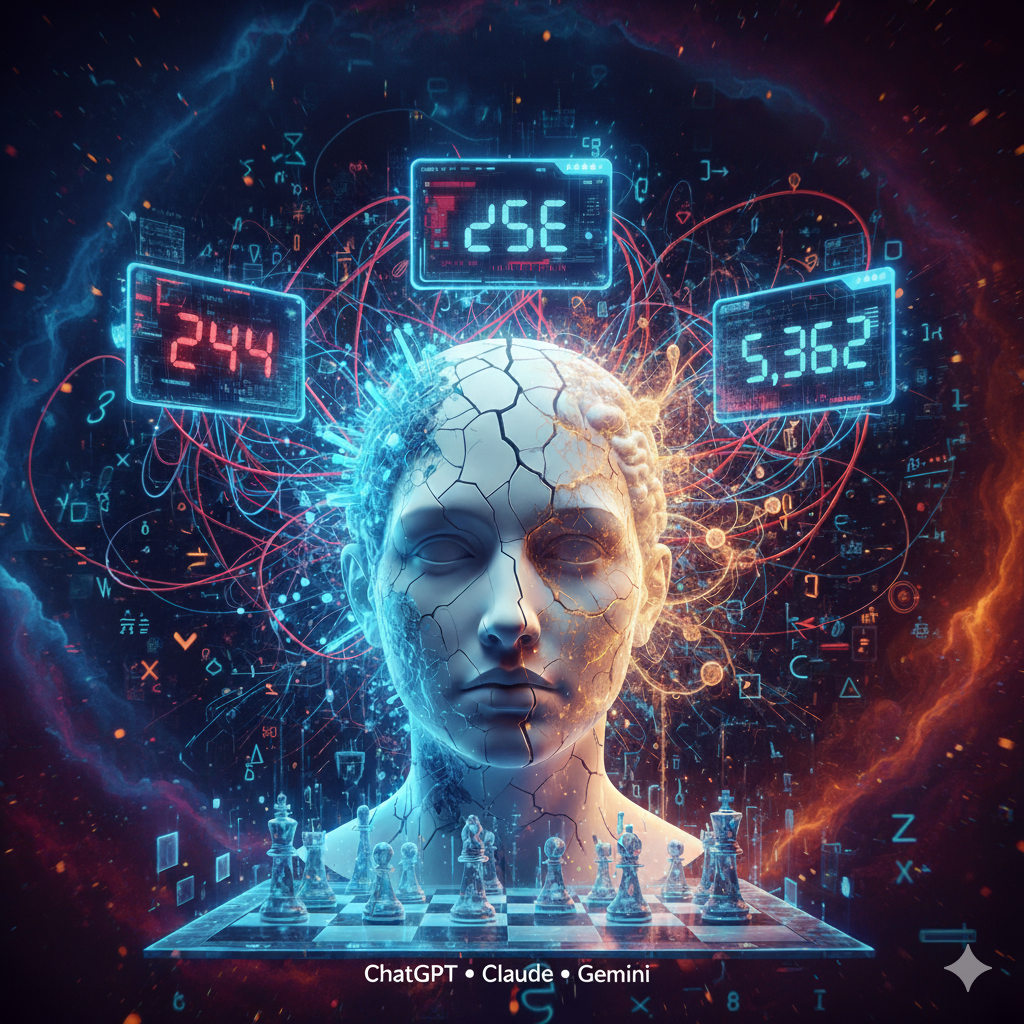“Language is a soft mirror reflecting a hard reality — and sometimes it bends the board.”
1. The Experiment
The question was simple — or so it seemed:
“In chess, after a white pawn move, a black knight move and a white knight move, how many possible legal positions are possible?”
Three AI engines were asked this question:
- ChatGPT answered 244
- Claude Sonnet 4 answered 256
- Gemini 2.5 Pro answered 5,362
Three minds.
One prompt.
Three truths.
2. The Logic Behind the Differences
Each system saw the same question through a different philosophical lens.
| AI Model | Interpretation | Result | Thought Pattern |
|---|---|---|---|
| ChatGPT | Simulated reasoning — move-by-move legality, contextual awareness | 244 | Human-like logical approximation |
| Claude Sonnet 4 | Simplified combinatorics — assumed independence of moves | 256 | Clean, elegant, slightly naïve logic |
| Gemini 2.5 Pro | Enumerative — counted all legal 3-ply chess positions | 5,362 | Database-driven pattern expansion |
Each was correct within its own frame of logic — but none reflected the absolute truth of chess.
3. The Heart of the Confusion: Ambiguity in Language
Chess is binary: a move is legal or it is not.
Language is probabilistic: meaning depends on interpretation.
The phrase “possible legal positions” contains at least four layers of ambiguity:
- Are we counting unique board arrangements or unique move sequences?
- Are all knight moves included, or only those unblocked by previous pawn moves?
- Do we allow transpositions (different paths to the same board)?
- Is “legal” defined strictly by chess rules, or relaxed as pseudo-legal moves?
Each AI “heard” the question differently — because language itself is a spectrum of meanings, not a coordinate system.
4. Chess as a Mirror for AI Reasoning
Chess represents perfect information, but language models represent imperfect interpretation.
| Domain | Chess Engine | AI Language Model |
|---|---|---|
| Nature | Deterministic | Probabilistic |
| Knowledge Type | State-based | Semantic |
| Representation | Board coordinates | Words and context |
| Goal | Accuracy | Plausibility |
| Truth System | Binary | Gradient |
A chess engine computes truth through enumeration.
A language model constructs meaning through approximation.
So when you ask an LLM a chess problem, you are really asking it to translate certainty into probability — and the translation always adds noise.
5. The Philosophy of Divergence
The divergence between 244, 256, and 5,362 isn’t just computational.
It’s philosophical.
- ChatGPT reasoned like a human teacher.
- Claude reasoned like a mathematician.
- Gemini reasoned like a statistical historian.
Each built its own small universe of truth — coherent inside, incompatible outside.
This mirrors human epistemology itself: knowledge isn’t a single mountain, but a constellation of hills.
6. When Perfect Games Meet Imperfect Language
Chess doesn’t lie.
Language does — gently, eloquently, and often by accident.
AI systems live in the space between certainty and expression.
They don’t “see” the board; they see patterns of meaning about the board.
And so, when asked for the number of possible positions, each model returns not the truth, but a reflection of how it understands truth.
🔹 Insight
AI’s challenge with chess isn’t about computation — it’s about comprehension.
A chess engine calculates reality; a language model imagines it.
And between calculation and imagination lies the philosophical gap where all intelligence — human or artificial — must learn to live.
7. Wittgenstein and the Limits of Language
“The limits of my language mean the limits of my world.” — Ludwig Wittgenstein, Tractatus Logico-Philosophicus
Wittgenstein believed that thought and language are inseparable.
In his Tractatus, he argued that anything we cannot express in language lies beyond reasoning.
Applied to chess, this means our capacity to conceptualize or even notice a strategic idea depends on whether it can be named.
We talk about pins, forks, and open files,
but if a pattern has no word, it often escapes awareness altogether.
AI, built upon human reasoning, therefore inherits our linguistic constraints — it can only model what we can describe.
Decades later, in his Philosophical Investigations, Wittgenstein reimagined meaning as use within context.
He famously remarked, “If a lion could speak, we would not understand him.”
Language gains meaning only through shared activity — through what he called forms of life.
Chess, in this view, is itself a language-game.
Knowing the word king or checkmate tells you nothing unless you’ve played.
Understanding arises not from definition but from participation.
This illuminates our three AI answers:
Each model interpreted the same question within its own language-game.
To ChatGPT, “possible positions” meant one thing; to Claude, another; to Gemini, something else entirely.
Each answer was internally logical but contextually isolated — a perfect echo of Wittgenstein’s insight that “no description can fully capture reality.”
The essence of a profound chess idea — a sacrifice, a positional tension — can be felt over the board, yet remain ineffable in language.
Here, Wittgenstein’s closing remark from the Tractatus whispers again:
“Whereof one cannot speak, thereof one must be silent.”
In that silence lies the boundary between computation and comprehension —
between logic and the ineffable art that even machines cannot name.
🪶 Reflective Summary
Wittgenstein’s philosophy reminds us that AI’s struggle with chess is not a failure of logic,
but a reflection of language’s imperfection.
We built AI from words — and words, like mirrors, always distort the light that passes through them.
When AI meets chess, it does not just play a game.
It performs a linguistic translation —
from the certainty of moves to the uncertainty of meaning.
And in that fragile translation,
the machine becomes human after all.

Leave a Reply